About Susan Leviton:
Susan Leviton of Harrisburg, PA describes herself as a “Jewish culture worker” committed to historic forms while seeking what is relevant and new to reflect contemporary life and experience. She is a singer, a papercutting artist and calligrapher, and and a fearless explorer of new media. In July 2020, she spoke with folklorist Amy Skillman about her artwork and about the joy of creating beautiful, meaningful things.
Her name is pronounced SOO-zun LEH-vih-tohn.
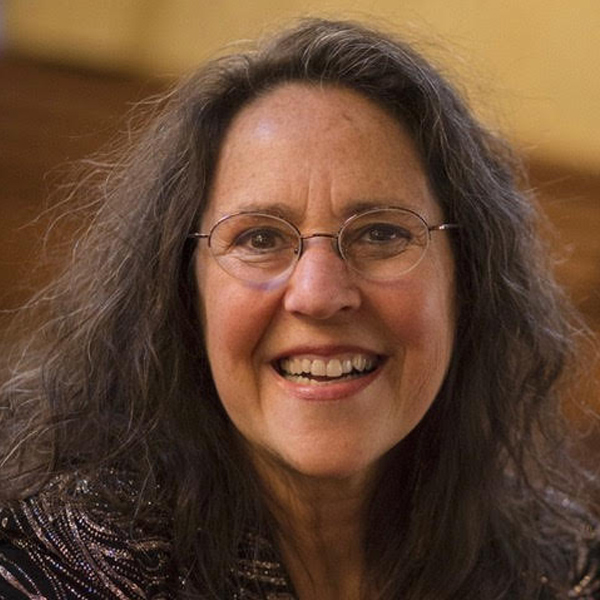
portrait of Susan Leviton courtesy of the artist
About Susan Leviton
A singer of traditional Yiddish songs
Most people who know Susan Leviton are familiar with her beautiful voice as a singer of traditional Yiddish songs. She grew up in a household where Yiddish was the comfortable hush spoken by the adults but not passed on to the children. When she began singing in the 60s and 70s, it was the folk song revival of Joan Baez, Phil Ochs, and Joni Mitchell that enchanted her. But, as she notes in the pages of her most recent CD Deep Skies, “I now find myself looping back to sing in Yiddish because the relevance, rhythm, and richness of the poetry and songs resonate with the deepest part of my singing soul.”
In the 1980s, she joined the Old World Folk Band as their lead singer, performing Yiddish theater songs, Klezmer, and Eastern European folk songs. More recently Susan branched out on her own, seeking opportunities to share rare and treasured Yiddish music that reflects her love of her heritage. She has recorded two CDs, both of which are full of carefully researched traditional Yiddish music and poetry. She notes, “These songs are not songs unless somebody sings them. If they sit in a published book on a dusty shelf, they’re not songs. I feel like I have gifts that would allow me to take something that would otherwise be static and give it life.”
And also a paper artist
Others might know Susan for the traditional Jewish calligraphy and papercut art she uses to design ketubot (Jewish marriage documents) and other certificates and awards. Drawing on the rich Jewish imagery of her heritage, Susan works closely with the recipients to incorporate symbols that have special meaning and connect to their lives.
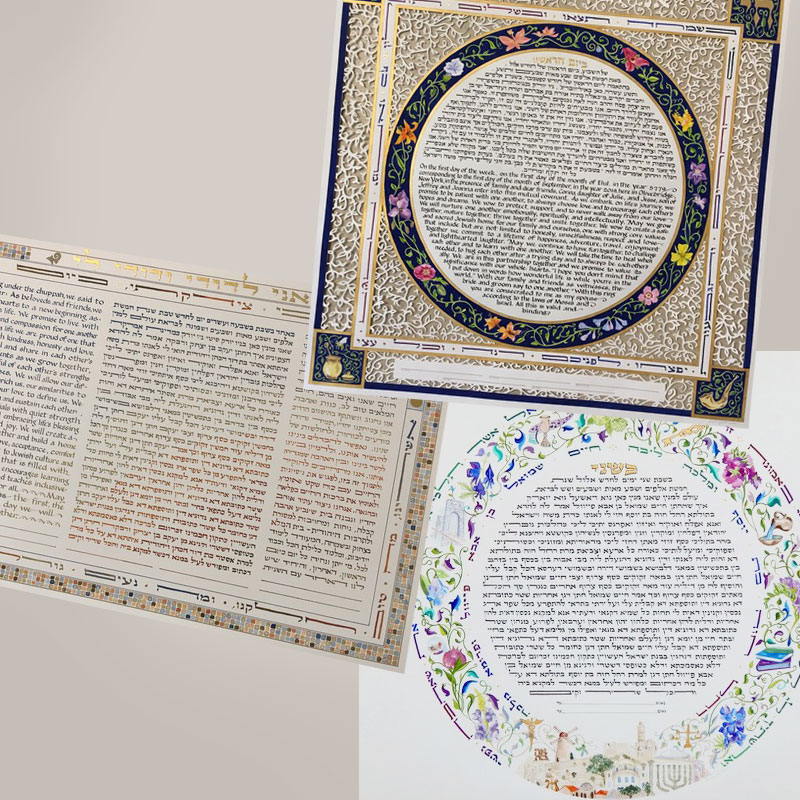
photos by Susan Leviton
Susan describes herself as a “Jewish culture worker” committed to historic forms while seeking what is relevant and new to reflect contemporary life and experience. Each document is unique; some are embedded with traditional Jewish symbols like the pomegranate or the peacock; others are enhanced with city skylines and scenes from meaningful places.
“This is why I love what I do, because it is never the same twice, and if I put my work into it, I can find the connections.”
Taking her work to new heights (literally)
In the last several years, Susan has taken that skill and commitment to new heights, designing a 10-foot high donor wall for the new Chisuk Emuna synagogue. The Chisuk Emuna congregation lost its synagogue and most of its ritual contents to an accidental fire in 2011. It was devastating. But as Susan noted, this is a congregation that does things with their hands.
People across the city offered assistance, from donations of money and supplies to a space for services and gatherings. They soon found a new location and began building anew. The new space opened in 2014 with a celebratory Dedication Day. The congregation carried their sacred Torah scrolls through the streets of the neighborhood and into their new home on a hill overlooking the community. The front lobby, designed to bring light into the space, is home to the four large panels Susan designed “to honor our donors, to put out the basic tenets of our congregation, and to tell a little bit of our history and who we are, visually as well as with words.”
When Susan was invited to design the donor wall, she saw it as an opportunity to reflect back while also looking to the future. “It seemed because I was connecting to a congregation that had Eastern European roots, that the idea of using a traditional art form in the 21st Century made perfect sense. It could have been anything; it could have been a mural, or anything. But the idea of the papercut art already says, this is part of our tradition.”
According to Joseph Shadur, a well-known scholar of Jewish folk art, traditional Jewish papercut dates back to the 14th Century and became another form of hiddur mitzvah — beautification of the commandments and rituals. The objects contain images and words drawn from Talmudic teachings and are created in some instances by cutting the design into a folded piece of paper. When the paper is unfolded, the symmetrical design is revealed. The real skill comes from creating intricate designs that hold together as one sheet of paper. They are often then painted to add depth and beauty.
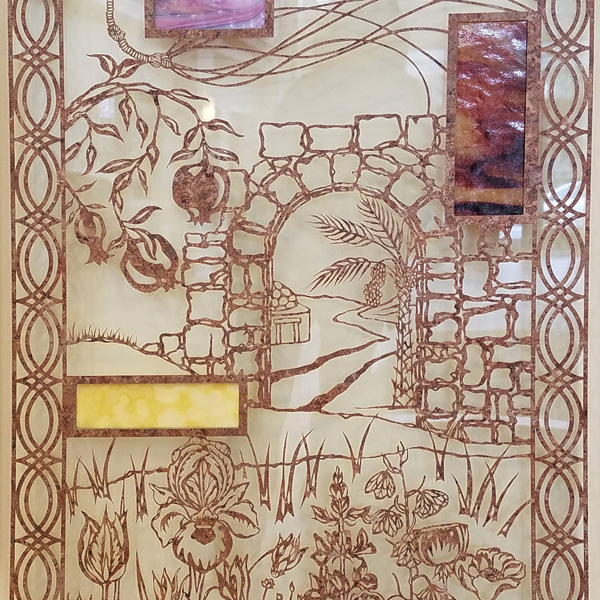
photo by Amy Skillman
“The whole thing is a way to remember, remember, remember what we are here to do and how it’s possible to do that.”
For the 10-foot high donor walls, Susan designed the four panels and then sent the designs to a company in Maine that cut the pattern out of thin plastic laminate. They are mounted upon sheets of half-inch thick acrylic and hung in place. The panels tell the story of the Chisuk Emuna congregation: “its beginnings as immigrants traveling from Lithuania to central Pennsylvania; the work of our hands, both the rituals we express with our hands and how we heal the world; the way we learn through the Torah; and finally, our history in Harrisburg.” The last panel features images of the four synagogues the congregation has inhabited since its founding in 1883. All the panels are filled with meaningful images and symbols: the birch trees of Lithuania, an open door, a small group carrying protest signs, a shofar, and more. The more you look, the more you will find.
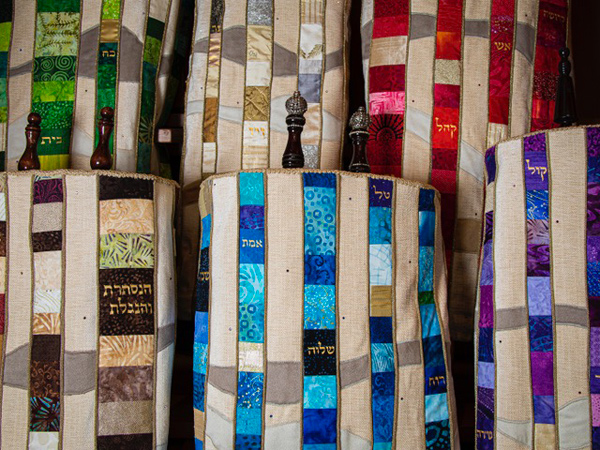
photo by Mark Glick
“I have a vision and I’ll figure it out”
As a multi-talented artist, Susan is able to translate her vision into just about any medium. After the damaged Torah scrolls were repaired, it was clear they were going to need new Torah covers. Susan jumped at the opportunity to make them. She chose colors that reflect the traveling Ark mentioned in the Torah — purples, blues, and scarlets — and used fabrics that incorporate all three to make them a family. The purple has some blues, the blue has some reds, etc. They are designed to complement the very modern sculpture of wood and glass that hovers above the Ark, drawing your eyes up in reflection.
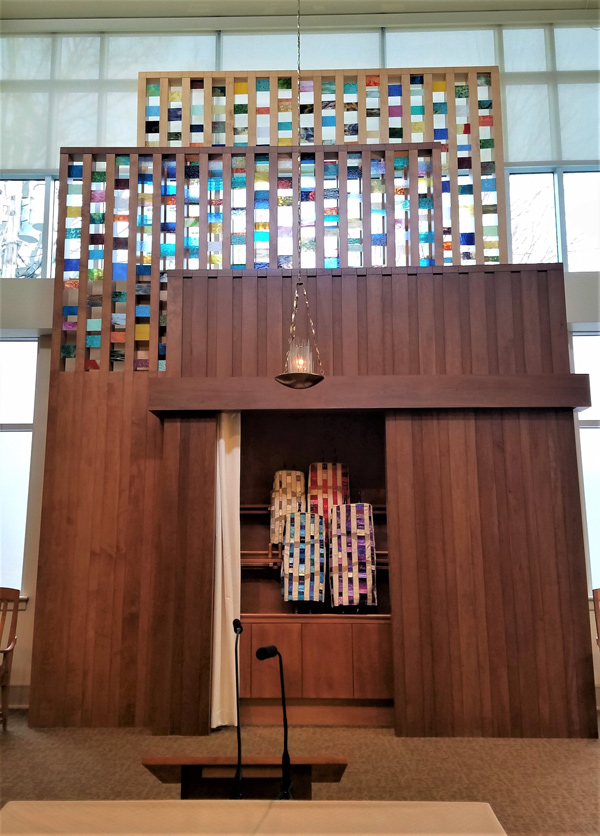
photo by Amy Skillman
Susan and her husband Gerry Gorelick discovered a crate of Youghiogheny glass at a yard sale and Susan has found ways to incorporate this beautiful opaque glass into the aesthetic of the entire synagogue. The donor panels are accented with rectangles of it, the sculpture over the Ark (where the Torah scrolls are housed) features those same rectangles, and she will soon embark on the creation of a glass mosaic for the sliding door of the Ark itself. She appreciates that this glass reflects and changes with the light and has created a design that will complement the other artistic elements in the Sanctuary.
For some, the transition from papercut and calligraphy to glass mosaic might seem daunting. But for Susan, whose veins throb with creativity, this is just another way to communicate a vision. After only two glass mosaic workshops and two small finished pieces, she is ready to tackle this new challenge. As she says, “One of the biggest gifts that I received, probably from my mother, was the idea that I could do anything; that I just could... So, dive in, figure it out. I have a vision and I’ll figure it out.”
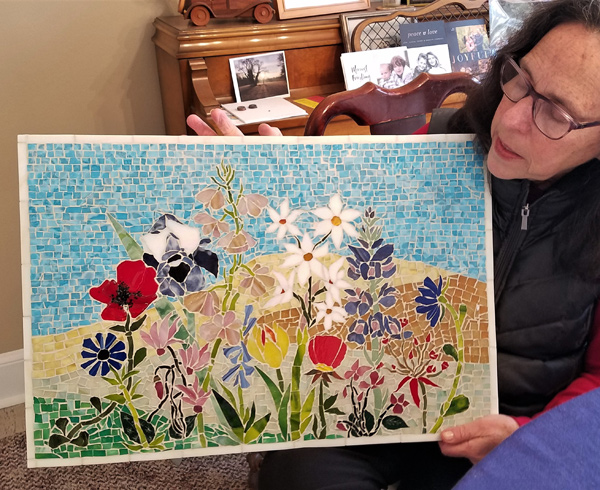
photo by Amy Skillman
Telling a story that needs to be heard
Susan is also a consummate educator. “To me, personally, I feel like I can tell a story through art. It is communication. And so much of my work life, whether it was interpreting for the Deaf or singing in a language that people don’t understand, it’s about communicating. And this is another form. This is telling a story that needs to be heard.”
She especially enjoys sharing her work with others, and is eager and adept at explaining the symbols and telling the story of her culture. “When people speak to an artist, they learn what went into making something or what it meant to the artist — what was intended. Whether they bring that art home with them or not, they own the knowledge. It goes back again to communication; to be able to bridge what I am capable of doing with what has meaning to somebody else, and gives somebody something else to think about, is very powerful... I’m still finding my way into stories, into ritual, into meaning and the joy of creating art is something that — I don’t just wake up in the morning and say I’m going to have joy. But I know it’s going to be fun.”


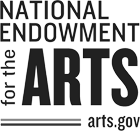
Brand icons for Facebook, YouTube, Instagram and other social media platforms are the trademark of their respective owners. No endorsement is implied.